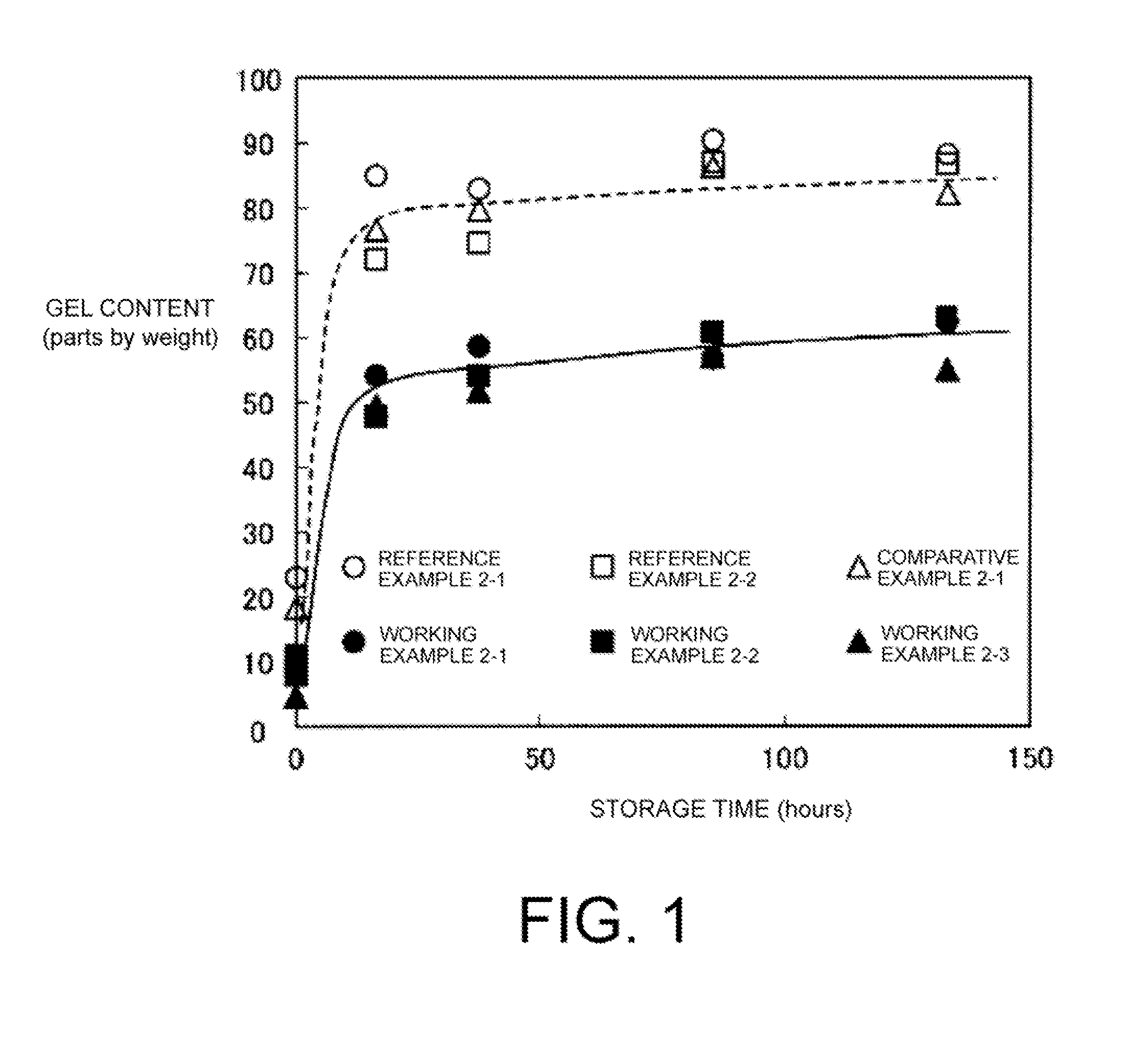Method for manufacturing natural rubber
- Summary
- Abstract
- Description
- Claims
- Application Information
AI Technical Summary
Benefits of technology
Problems solved by technology
Method used
Image
Examples
first embodiment
[0031]A method for manufacturing natural rubber according to a first embodiment of the present technology includes: adding to a natural rubber latex at least one type of sulfonic acid selected from the group consisting of a monoalkyl sulfonic acid expressed by Formula (1) below, a polyoxyethylene alkyl ether sulfonic acid expressed by Formula (2) below, and an alkylbenzene sulfonic acid expressed by Formula (3) below; and, thereafter, removing moisture from the mixture of the natural rubber latex and the sulfonic acid.
R1OSO3H (1)
[0032](wherein R1 is an alkyl group having from 1 to 20 carbons);
R2O(CH2CH2O)nSO3H (2)
[0033](wherein R2 is an alkyl group having from 1 to 20 carbons and n is an integer from 1 to 20);
R3C6H4SO3H (3)
[0034](wherein R3 is an alkyl group having from 1 to 20 carbons).
[0035]In the method for manufacturing natural rubber of the present technology, filtered field latex extracted from rubber trees or a concentrated natural rubber latex made by treating the field l...
second embodiment
[0051]Next, a method for manufacturing natural rubber according to a second embodiment of the present technology will be described.
[0052]The method for manufacturing natural rubber according to the second embodiment of the present technology includes performing a treatment to remove the magnesium present in the natural rubber latex prior to adding the sulfonic acid.
[0053]This embodiment is the same as the method for manufacturing natural rubber according to the first embodiment described above, except for the performing the treatment to remove the magnesium present in the natural rubber latex prior to adding the sulfonic acid. Therefore, descriptions of aspects that are the same as in the method for manufacturing natural rubber according to the first embodiment are omitted.
[0054]With the method for manufacturing natural rubber according to this embodiment, first, in order to remove the magnesium present in the natural rubber latex, a water soluble compound that produces a magnesium ...
example 1
[0060]As shown by the formulations in Tables 1 and 2, twelve types of natural rubbers (Working Examples 1-1 to 1-7 and Comparative Examples 1-1 to 1-5) were prepared as follows: The sulfonic acid or reagent was dissolved in water and added while slowly stirring so as to be 1.0 or 0.5 parts by weight per 100 parts by weight of the solid component in the natural rubber latex and was then mixed / stirred using a mechanical stirrer. Thereafter, the products were dried under common conditions of spraying at a flow of 2 L / hour into an atmosphere of shock waves generated by pulse combustion (frequency: 1,000 Hz, temperature: 60° C.) using a pulse combustion shock wave drying apparatus (Hypulcon small laboratory dryer made by Pultech Corporation). The type of sulfonic acid or reagent used, added amounts thereof, and mixing / stirring times were varied as shown in Tables 1 and 2. Note that the sulfonic acid and reagent was not added to the natural rubber latex of Comparative Example 1-1 and, aft...
PUM
| Property | Measurement | Unit |
|---|---|---|
| Temperature | aaaaa | aaaaa |
| Temperature | aaaaa | aaaaa |
| Temperature | aaaaa | aaaaa |
Abstract
Description
Claims
Application Information
 Login to View More
Login to View More - R&D
- Intellectual Property
- Life Sciences
- Materials
- Tech Scout
- Unparalleled Data Quality
- Higher Quality Content
- 60% Fewer Hallucinations
Browse by: Latest US Patents, China's latest patents, Technical Efficacy Thesaurus, Application Domain, Technology Topic, Popular Technical Reports.
© 2025 PatSnap. All rights reserved.Legal|Privacy policy|Modern Slavery Act Transparency Statement|Sitemap|About US| Contact US: help@patsnap.com

